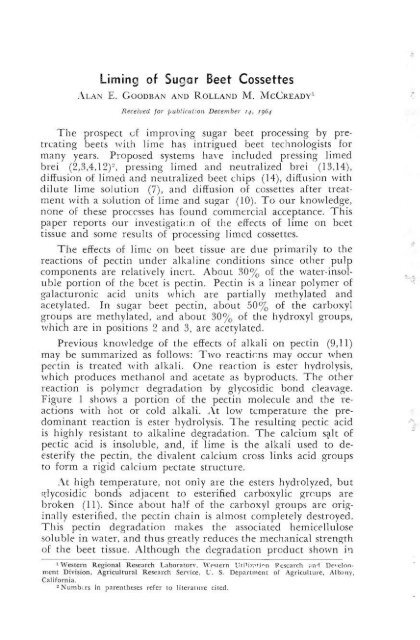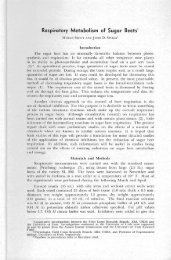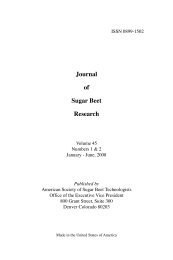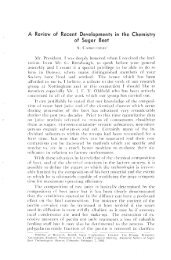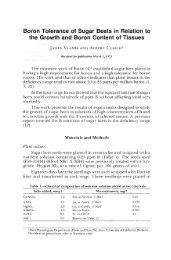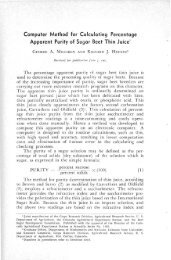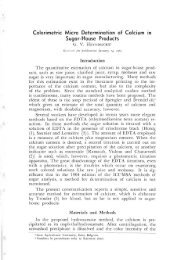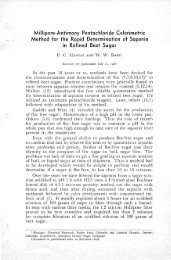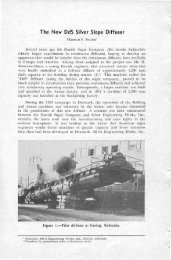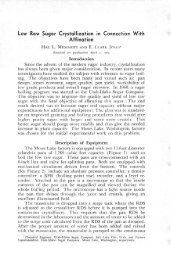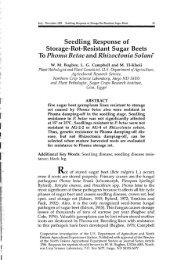liming of Sugar Beet Cassettes - Vol
liming of Sugar Beet Cassettes - Vol
liming of Sugar Beet Cassettes - Vol
You also want an ePaper? Increase the reach of your titles
YUMPU automatically turns print PDFs into web optimized ePapers that Google loves.
568 JOU RNAL OF THE .\. S. S. B. T.<br />
Similar tests 'with cassettes showed that after ten minutes<br />
<strong>liming</strong> at 25 c C only a narrow band <strong>of</strong> esterified pectin remained<br />
in the center <strong>of</strong> the cossette. The greater penetration into cossettes<br />
can be explained by considering the cossette structure<br />
shown in Figure 2. The numerous transverse cracks allow the<br />
lime to penetrate rapidly which results in more extensive deesterification<br />
than would be predicted hom the results on<br />
microtome-cut pieces.<br />
Figure 2.--<strong>Sugar</strong> beet cossettes showing u-ansverse cracks.<br />
Saponification Rates<br />
De-esterification and deacetylation rates wen' obtained by<br />
measuring the residual ester and acetyl content <strong>of</strong> pulp after reaction<br />
with lime. Cossettes were mixed with dry Ca(OH)" and<br />
held at 25° C. Samples were withdrawn at timed intervals and<br />
the acetyl and methoxyl content <strong>of</strong> the marc measured (5) . The<br />
results were calculated as percent saponification, and are shown<br />
in Figure 3. The rate <strong>of</strong> demethylation is greater than the rate<br />
<strong>of</strong> deacetylation at this temperature. Demethylation stabilizes<br />
pectin, but deacetylation does not, and furthermore, it produces<br />
.
VOL. 13, :"0. /, OCTOllER 1960<br />
SAPONIFICATION OF BEET PECTIN<br />
100 Cossettes treated with dry lime at 25°<br />
80<br />
c:<br />
o 60<br />
'';;<br />
(\l<br />
u<br />
;;::<br />
c:<br />
o<br />
g- 40<br />
tf)<br />
20<br />
Methoxyl<br />
10 20 30 40<br />
Time, minutes<br />
569<br />
Figure 3.-Saponification <strong>of</strong> beet pectin. Rate <strong>of</strong> de-esterification<br />
and deacetylation. Cossettes treated at 25 ° C with dry Ca(OH)2' Ul%<br />
on beets.<br />
acetic acid as a byproduct. Since demethylation is more rapid<br />
than deacetylation, it may be possible to restrict deacetylation<br />
and still stabilize pectin by sufficient demethylation.<br />
Processing Tests<br />
Several different processing procedures were eval uated by<br />
examining diffusion juice and thin juice from treated beets.<br />
Diffusion was carried out in a Brriniche-Olsen laboratory diffuser<br />
with a feed rate <strong>of</strong> 9 kg <strong>of</strong> beets per hour. First carbonation was<br />
continuous, in a Dorr-type laboratory carbonator (8). Thin juice<br />
was made by batch second carbonation <strong>of</strong> fihered first-carbonation<br />
juice. Cossettes were limed in the following four ways:<br />
I) dry Ca(OH)2 pre<strong>liming</strong>, 2) lime slurry pre<strong>liming</strong>, 3) direct<br />
<strong>liming</strong> in the diffuser, and 4) countercurrent washing with limed<br />
diffusion juice. Cossette <strong>liming</strong> was either at room temperature<br />
(less than 25 ° C) or at 40 ° C, using 0.4 to 1.0% CaO on beets.<br />
Diffusion temperature was 70 ' or 25 " C with alkaline beels, and<br />
was 70° C with limed beets 'which had been neutralized with
570 ] OCR:\AL OF THE . \. S. S. B. T.<br />
COe. Liming at 40 ° C was unsatisfactory because o[ pulp deterioration.<br />
Lime slurry treatments were difficult to manage<br />
because <strong>of</strong> the rapid extraction <strong>of</strong> sugar, even at low temperature.<br />
For continuous operation, a system <strong>of</strong> adding treatment<br />
liquor to the diffusion juice at a constant rate would be needed.<br />
Dry <strong>liming</strong> vvas easier, and still gave satisfactory treatment to<br />
the beets. Treatment levels above 0.4% CaO on beets were<br />
unnecessary. Diffusion juice from alkaline beets was clear and<br />
light colored. Juice from neutralized beets was darker, vvith<br />
more colloids, but still much lighter and clearer than normal<br />
diffusion juice. /\.11 <strong>of</strong> the diffusion juices were subjected to<br />
first carbonation, with additional lime. Sedimentation and filtration<br />
rates were determined on the first carbonation juices, and<br />
the color, lime salts, and purity <strong>of</strong> the second carbonation juices<br />
were measured. Table I is a summary <strong>of</strong> the results from the<br />
best three treatments. The major differences are in the total<br />
lime consumption and in the lime salts and total anions. The<br />
final mud volumes are a reflection <strong>of</strong> the amount <strong>of</strong> lime used.<br />
Table I.-Processing comparisons for prelimed beelS<br />
Cosseltcs limed at room temperature with<br />
dry Ca (HO)" (0.4% CaO on beets)<br />
Control Alkaline Nentral<br />
Pre<strong>liming</strong> time, min. none 30 30 10<br />
Diffusion temp.• · C.<br />
FiTSt carbonation:<br />
70 2:; 70 70<br />
I.ime added (% CaO on beets ) 2.0 0. 5 0.5 1.0<br />
Sedimentation resistance 25 32 31 34<br />
Mud volume ( % )<br />
Second carbonation:<br />
9.0 5.0 5.0 7.0<br />
J.ime salts (CaO/IOO Bx) .05 .52 .39 .18<br />
Anions (meq./IOO Bx) 31 50 55 51<br />
Purity (%)<br />
Color (00/ 100 Bx)<br />
91.6<br />
2.0<br />
The total lime consumption for the alkaline-diffused beets was<br />
0.9 % , for the neutralized beets 1.4%, and for the control beets<br />
2.0% GaO on beets. Lime salts and anions are high in the second<br />
carbonation juice from the limed beets because <strong>of</strong> acetate liberated<br />
from the pectin. The increase in total acids was matched<br />
by the increase in volatile acids, which we assume to be acetic<br />
acid. These excess anions prevent the removal <strong>of</strong> lime by carbonation<br />
without the addition <strong>of</strong> corresponding cations. The<br />
sodium carbonate needed to reduce the lime salts to the level<br />
<strong>of</strong> the control is calculated to be 0.05 to 0.15% on beets. The<br />
increase in anions, calculated as acetate, plus the increase in<br />
lime salts, calculated as calcium ion, is 1.3 to 1.7 grams per 100<br />
89.5<br />
2 . .0<br />
90.2<br />
2.8<br />
90.0<br />
2.8
VOL. 13, No.7, OCTOIlER 1965 57]<br />
gTams <strong>of</strong> solids in second carbonation juice. \\,ithin experimental<br />
error, this is the same as the observed drop in purity for<br />
juices from limed beets. Prelimed cossettes do retain more colloids<br />
and insoluble calcium salts than do untreated cossettes,<br />
but these are materials which would be removed during carbonation.<br />
There is no net change in the amount <strong>of</strong> soluble<br />
nonsugars in second carbonation juice, except for acetate produced<br />
by deacetylation <strong>of</strong> pulp pectin.<br />
Pulp from prelimed beets is much tougher than normal<br />
pulp. Laboratory tests showed that up to 40% solids could be<br />
obtained using a static press but that the pulp was too tough<br />
to be pressed in a high-speed screw press. \Ve were unable to<br />
test pulp from prelimed beets in a factory press without introducing<br />
the system to an entire factory, but we have made<br />
some fac tory tests on pulp from a continuous slope diffuser by<br />
adding lime after diffusion. Pulp treated with 0.15% CaO becomes<br />
hard and tough in the same way as do the cassettes. Dry<br />
hydrated lime or a slurry <strong>of</strong> lime was added to the pulp in the<br />
conveyor system feeding the presses. The temperature was 45°<br />
to 50 " C. Although the trials were not extensive, it does seem<br />
that lime-hardened pulp can be pressed satisfactorily. In one<br />
trial, about 100 tons <strong>of</strong> pulp were treated at the rate <strong>of</strong> 0.15%<br />
CaO on pulp over a period <strong>of</strong> two hours, and the pulp was<br />
pressed on two or three Stearns-Rog'ers presses to about 83%<br />
moisture, which was the same as for untreated pulp. On two<br />
occasions, lower moistures ,""ere obtained for brief periods, but<br />
the presses plugged, either because the bottom piates were too<br />
tight or because not enough pressure could be developed to<br />
force the pulp through the discharge slot. The power consumption<br />
on the presses was not excessive, even when they were<br />
plugged.<br />
Summary<br />
Cossette pre<strong>liming</strong> at low temperature stabilizes the beet<br />
structure to permit alkaline diffusion without disintegration <strong>of</strong><br />
the pulp. Considerable retention <strong>of</strong> otherwise extractable colloids<br />
is observed, leading to a reduction in the lime needed for<br />
clarification. The production <strong>of</strong> acetate by alkaline deacetylation<br />
reduces the purity <strong>of</strong> clarified juice and incrcasL's the amount <strong>of</strong><br />
lime salts.<br />
The pre<strong>liming</strong> <strong>of</strong> cossettes must be carried out below 40°<br />
C and sufficient time must be allmved for the pectin to be<br />
stabilized. before it is subjected to heat. Alkaline diffusion may<br />
presumably be conducted over a 'wide range <strong>of</strong> temperature. The<br />
high pH will preclude fermentation at low temperatures, and<br />
the stabilized pectin will permit unusually high temperatures


